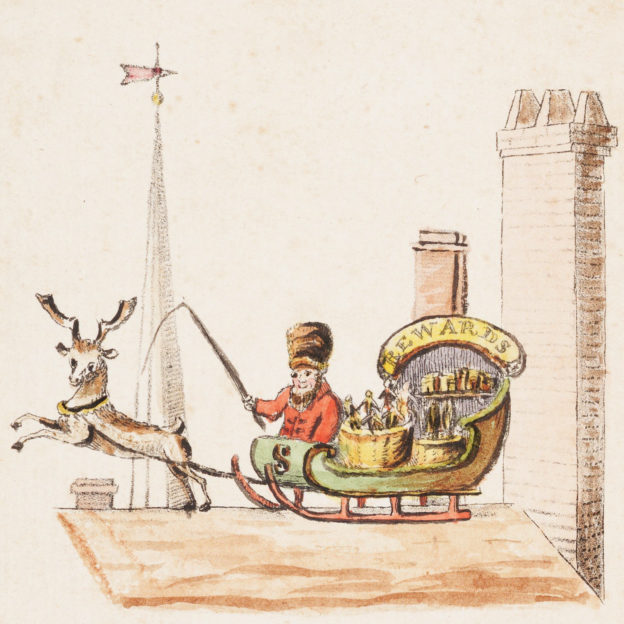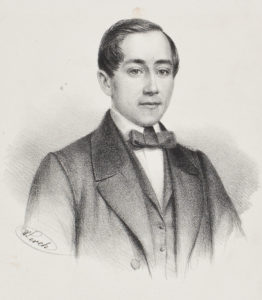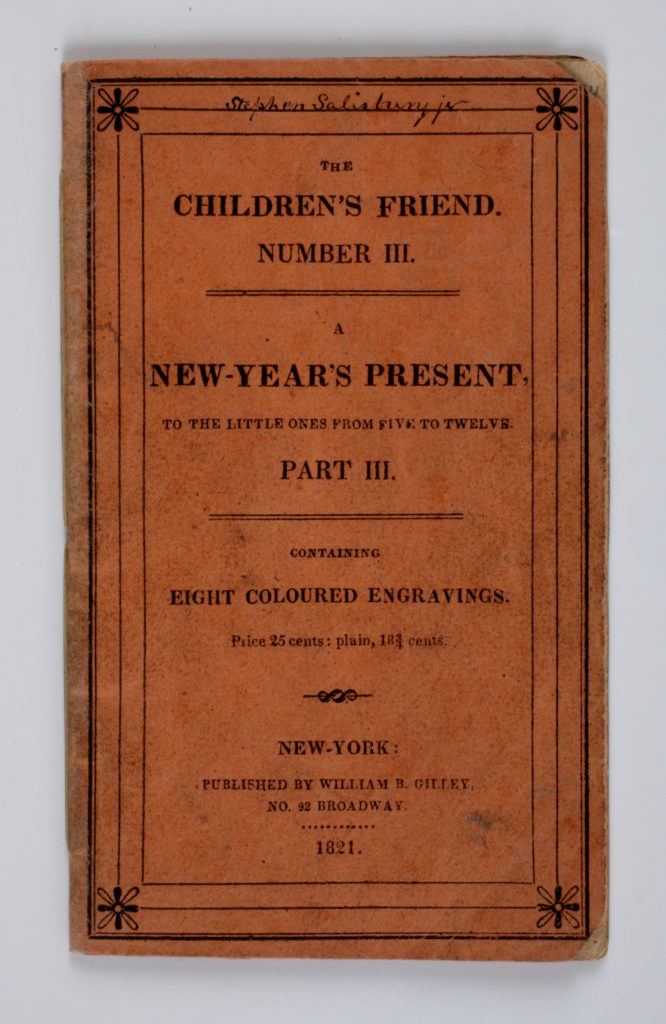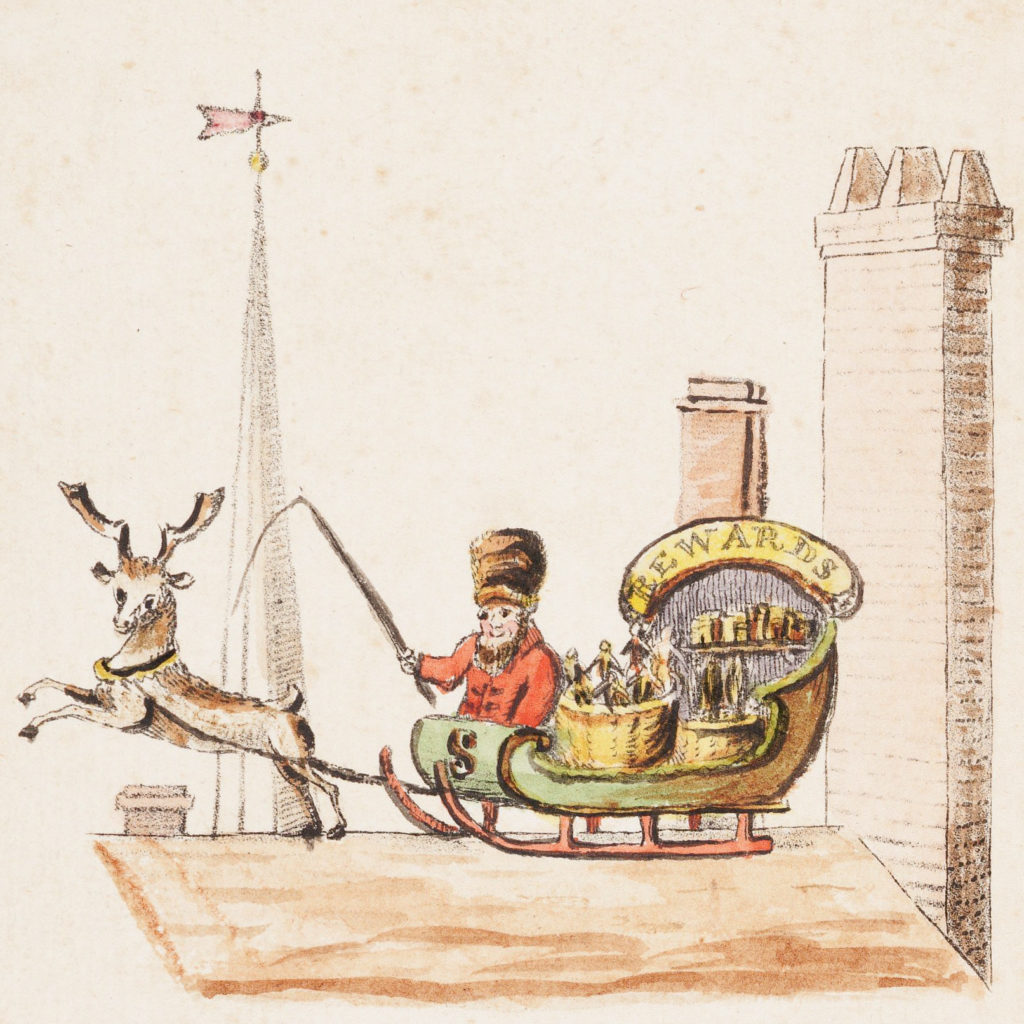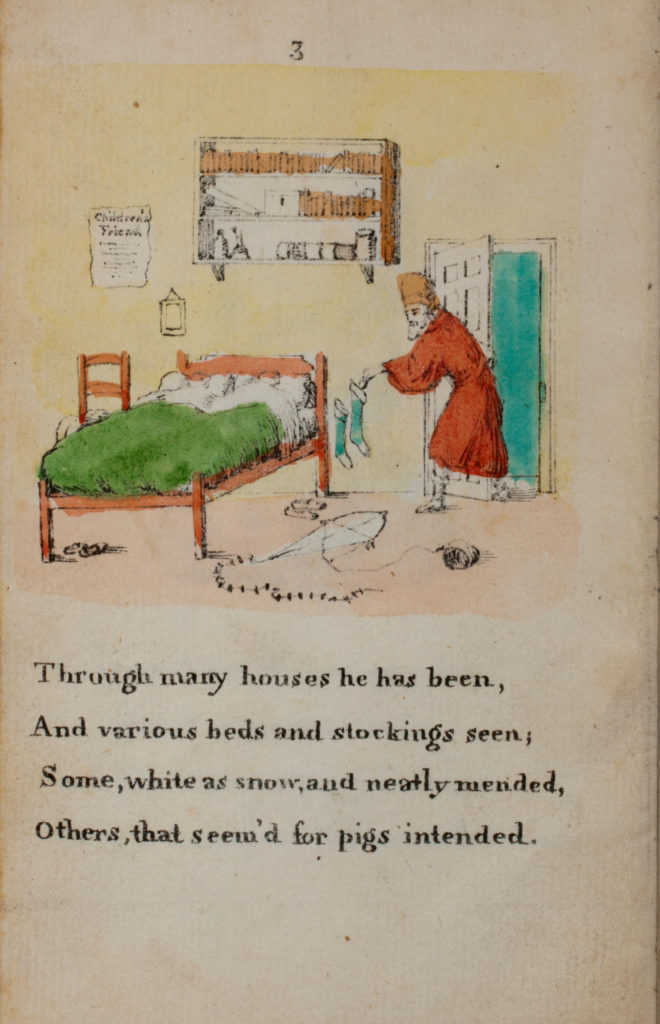Most members of the American Antiquarian Society are aware of the enormous contributions made by the Salisbury family of Worcester County, Massachusetts. Stephen Salisbury II served as president of the Society from 1854 until his death in 1884, and his son, Stephen Salisbury III, served as president from 1887 until his death in 1905. (A half-length portrait of Stephen Salisbury III, as a young man, c.1856 appears below.)
Stephen Salisbury III also bequeathed his personal papers—a hundred bound volumes and sixty-seven boxes of materials collected over seventy years—to the Society. As archivists catalogued these items, they discovered an eight-page pamphlet, The Children’s Friend: Part III, A New-Year’s Present to the Little Ones from Five to Twelve, that had been a Christmas gift to six-year-old Stephen in 1841.
Published by New York bookseller William B. Gilley in 1821, The Children’s Friend contains the first visual depictions of “Santeclaus,” a warmly bundled and bearded gift-giver who traveled from house to house on Christmas Eve in a sleigh drawn by a flying reindeer. The publication, which will mark its bicentennial next year, quickly disappeared from public consciousness, but the story lived on as “The Night Before Christmas,” a poem written by Clement C. Moore, a neighbor of Gilley, in 1822. The fact that young Stephen saved the booklet his entire life is remarkable both because it illustrates the importance of the Society’s work to “collect, organize, and preserve the records of the lives and activities of people who have inhabited this continent” and because it allows us to document the arrival of Santa Claus in America in 1821.
 The rediscovery of The Children’s Friend more than a century after its publication was announced by Charles W. Jones, a Berkeley historian widely viewed as one of the world’s experts on St. Nicholas, in a 1953 speech to the New-York Historical Society. Jones, however, treated Gilley’s book as little more than a historical footnote on the source of Santa’s reindeer.[1] Jones’ primary argument was that author Washington Irving “made” Santa Claus in A History of New York, an 1809 satire about the Dutch government of Manhattan.[2] “Without Irving there would be no Santa Claus,” Jones asserted. “The History contains no less than twenty-five allusions to him—many of them the most delightful flights of imagination . . . Santa Claus was a parasitic germ until the Knickerbocker History in 1809; after 1809 Santa Claus spread like a plague which has yet to reach its peak.” [3]
The rediscovery of The Children’s Friend more than a century after its publication was announced by Charles W. Jones, a Berkeley historian widely viewed as one of the world’s experts on St. Nicholas, in a 1953 speech to the New-York Historical Society. Jones, however, treated Gilley’s book as little more than a historical footnote on the source of Santa’s reindeer.[1] Jones’ primary argument was that author Washington Irving “made” Santa Claus in A History of New York, an 1809 satire about the Dutch government of Manhattan.[2] “Without Irving there would be no Santa Claus,” Jones asserted. “The History contains no less than twenty-five allusions to him—many of them the most delightful flights of imagination . . . Santa Claus was a parasitic germ until the Knickerbocker History in 1809; after 1809 Santa Claus spread like a plague which has yet to reach its peak.” [3]
Although widely accepted by historians for almost seventy years, Jones’ thesis was premised on several demonstrable errors.[4] The most fundamental error was that Jones used the wrong edition of Irving’s History. The publication date is critical because the premise of Jones’ argument was that Irving’s History prompted publication of two poems about St. Nicholas in December 1810 and an 1813 book, False Stories Corrected, that sought to debunk the legend of “Old Santaclaw.”[5] Assuming that the references to St. Nicholas in Irving’s History were published in 1809, and conflating St. Nicholas with Santa Claus, Jones concluded that Irving was responsible for popularizing the St. Nicholas tradition in America.
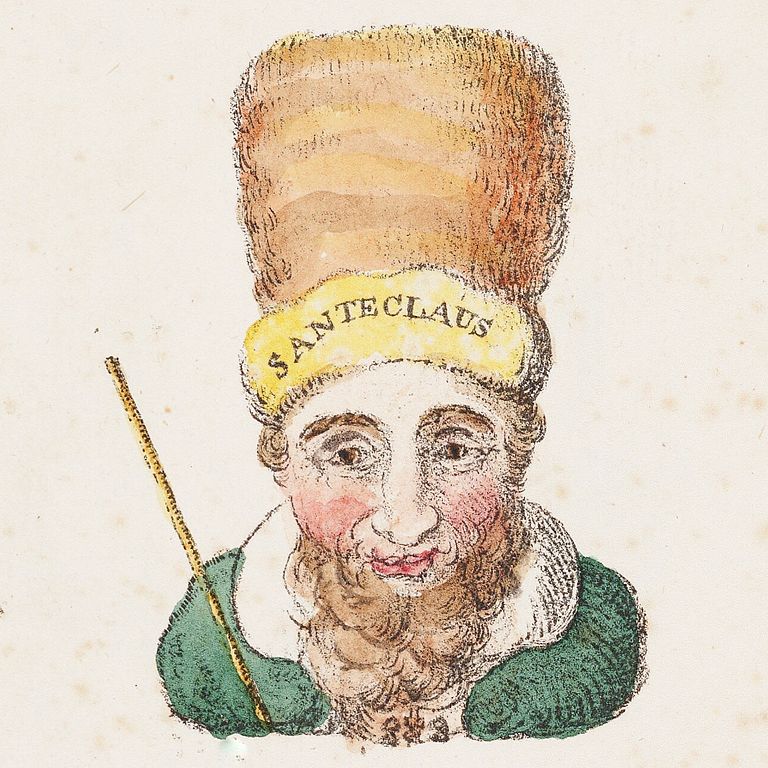 Unfortunately, Jones was using the 1812 edition of Irving’s book rather than the 1809 edition. More than half of the twenty-five references to St. Nicholas cited by Jones, and all of the critical paragraphs about St. Nicholas’ gift-giving practices, were added by Irving in the 1812 edition. Because the Dutch poems were published before the second edition of Irving’s History, Jones could not fairly credit Irving with inventing anything, much less the story of Santa Claus. Nevertheless, virtually all of the historians who have written about the development of Santa Claus since 1954 have uncritically adopted Jones’ thesis, and none seems even to have realized Jones was working with the wrong edition of Irving’s book.
Unfortunately, Jones was using the 1812 edition of Irving’s book rather than the 1809 edition. More than half of the twenty-five references to St. Nicholas cited by Jones, and all of the critical paragraphs about St. Nicholas’ gift-giving practices, were added by Irving in the 1812 edition. Because the Dutch poems were published before the second edition of Irving’s History, Jones could not fairly credit Irving with inventing anything, much less the story of Santa Claus. Nevertheless, virtually all of the historians who have written about the development of Santa Claus since 1954 have uncritically adopted Jones’ thesis, and none seems even to have realized Jones was working with the wrong edition of Irving’s book.
Even if one ignores that Jones was using the wrong edition of Irving’s History, however, the historical evidence does not justify giving Irving credit for creating Santa Claus. One flaw, noted above, is that Jones erroneously conflates Santa Claus, a secular figure who gives gifts on Christmas, with St. Nicholas, a Catholic saint who distributes gifts on his feast day, December 6. In fact, they were different figures with different gift-giving practices, and St. Nicholas had been known in Europe for centuries.
Another flaw in Jones’ thesis is that there was no plague of Santas following 1809, much less one that could be fairly attributed to Irving’s satire. When Moore’s “Night Before Christmas” was published on December 23, 1823, there were only two other works published in America about Santa Claus, and all of them belie the claim that Irving’s History played any significant role in the development of Santa Claus. Moore’s poem was republished about once a year in small town newspapers for several decades, but it would be the late 1850s before Santa reached plague proportions.
The earliest of these works, False Stories Corrected, sought to correct the myth of “Old Santaclaw, of whom so often little children hear such foolish stories; and once in the year are encouraged to hang their stockings in the Chimney at night.”[6] While Jones cites this book as an example of Santa Claus spreading like a plague, Jones assumed it was published four years after Irving’s History. The second edition of Irving’s History, however, would have been out only a year when False Stories Corrected was published in 1813, which is not long enough to conclude “Santaclaw” came once a year. The only logical interpretation of this evidence is that the legend of Santa Claus arose in the early nineteenth century through oral tradition among European immigrants.
The second work cited by Jones was The Children’s Friend itself, whose story of “Santeclaus” filling children’s stockings with treats on Christmas Eve owed no apparent debt to Irving’s History. The St. Nicholas described in Irving’s History dressed like a Dutchman, presumably clean shaven, with a low, broad-brimmed hat, a pair of Fleming trunk hose, knickers, and buckled shoes, a description that looks nothing like the illustration of “Santeclaus” in The Children’s Friend. Rather, Gilley’s book describes the gift-givers and practices that developed in the Protestant regions of Germany after use of a Catholic saint as gift-giver lost favor following the Reformation. These secular gift-givers, who went by at least two dozen different names, including several close variants of Santa Claus, were scruffy, bearded men who wore long fur cloaks or coats and typically carried a bundle of switches to deal with naughty boys. Gilley and illustrator Arthur Stansbury added the flying reindeer but the primary inspiration for “Santeclaus” was almost certainly the secular gift-bringers who followed the millions of Germans immigrants to America in the early 1800s.
The third work that Jones viewed as a descendant of Irving’s History was “The Night Before Christmas,” which used the name St. Nicholas to describe the Christmas gift-giver and included two stanzas which were clearly an allusion to Oloffe’s Dream, a scene in Irving’s History in which smoke from St. Nicholas’ pipe swirls around head. While these two facts that may have led Jones to assume Moore was more influenced by Irving’s History than he was, there is compelling circumstantial evidence that Moore lifted virtually everything but the allusion to Oloffe’s Dream and one of the eight reindeer from The Children’s Friend. Moore’s winter home and office at General Theological Seminary were only yards from Gilley’s printing shop on south Broadway, and Moore in all likelihood did business with Gilley both on behalf of the seminary and on his own account. One possibility is Moore bought a copy of The Children’s Friend in 1821 to give to his oldest daughter on Christmas but found the verse too mean-spirited and, therefore, wrote his own, child-friendlier version in 1822.
Even without direct evidence, the geographic proximity between the two authors, the temporal proximity between the two poems, the strong similarities between the two stories, and otherwise inexplicable details like flying reindeer in both poems, compel the conclusion that Moore borrowed the story from The Children’s Friend. It was Moore’s writing, however, that made the difference between a children’s book that came close to being lost in history and one of the best-loved works in American literature, a poem that is still read aloud by millions of parents every Christmas Eve and has the same literary appeal it did almost two hundred years ago. Gilley and Stansbury, however, deserve credit for the first visual depiction of the American gift-giver, creating the template for arrival of Santa in a flying sleigh on Christmas Eve and the family-centric celebration on Christmas morning.
These facts make The Children’s Friend one of the rarest and most significant Christmas documents in American history, and we owe its discovery to a six-year-old boy, Stephen Salisbury III, who saved a childhood gift of no obvious monetary or historical value and, many decades later, donated it to the Society.
Notes
[1] The speech was published in 1954. See Charles W. Jones, “Knickerbocker Santa Claus,” New-York Historical Society Quarterly, No. 38, 356-83 (1954).
[2] Washington Irving, A History of New York (New York: Inskeep and Bradford, 1809).
[3] Jones, “Knickerbocker Santa Claus,” 374.
[4] See Santa Claus Worldwide: A History of St. Nicholas and Other Gift-Bringers (Jefferson, N.C.: McFarland & Co., 2020), 212 n.6 (28 scholarly books and articles from 1954 to 2017 that credit Irving with creating Santa Claus based on Jones’ thesis).
[5] False Stories Corrected (New York: Samuel Wood, 1813), 68.
[6] False Stories Corrected, 68.
 Tom A. Jerman is a retired attorney who lives in Asheville, N.C. This post is adapted from his book, Santa Claus Worldwide: A History of St. Nicholas and Other Gift-Bringers (Jefferson, N.C.: McFarland & Co., 2020).
Tom A. Jerman is a retired attorney who lives in Asheville, N.C. This post is adapted from his book, Santa Claus Worldwide: A History of St. Nicholas and Other Gift-Bringers (Jefferson, N.C.: McFarland & Co., 2020).

